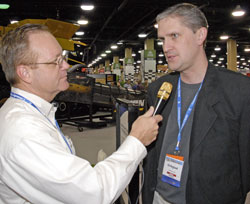John Deere Risk Protection has introduced the industry’s first-ever Ethanol Policy by providing coverage to corn producers who have delivery contracts for the purpose of ethanol production.
 The policy was officially introduced at the end of January and Deere has been talking with growers at events during the last month, including the Farm Machinery Show and last week’s Commodity Classic.
The policy was officially introduced at the end of January and Deere has been talking with growers at events during the last month, including the Farm Machinery Show and last week’s Commodity Classic.
Deere held a press conference at Classic where Dennis Daggett, Director of Marketing for John Deere Risk Protection, explained the policy to the ag media.
 Very simply, the policy insures yield shortfalls below contracted volumes in the event the price to replace the corn rises above the federal crop insurance coverage. The policy is being offered in Iowa, Illinois, Indiana, Kansas, Minnesota, Missouri, Nebraska, Ohio, South Dakota, and Wisconsin. “We offered it where the majority of the active ethanol plants are in existence today,” Daggett says.
Very simply, the policy insures yield shortfalls below contracted volumes in the event the price to replace the corn rises above the federal crop insurance coverage. The policy is being offered in Iowa, Illinois, Indiana, Kansas, Minnesota, Missouri, Nebraska, Ohio, South Dakota, and Wisconsin. “We offered it where the majority of the active ethanol plants are in existence today,” Daggett says.
Since they introduced the policy, Daggett says there has been a lot of buzz in the industry. “We have fairly modest expectations on the product itself because we know that there is a very specific type of farmer who would be interested in this product, a farmer who actually contracts more than 50 percent.”
Daggett says the policy is beneficial for the ethanol plants because it allows them to actually work with the farmer in case there is a shortfall on their delivery contract. “We think this is a win for the ethanol plants because it stabilizes their input of grain and stabilizes their relationship with the farmer.”
Listen to an interview with Dennis about the ethanol policy here:
[audio:http://www.zimmcomm.biz/john-deere/cc-jd-daggett.mp3]
Domestic Fuel coverage of the 2008 Commodity Classic
is sponsored by: 
 Enterprise Rent-A-Car and VeraSun Energy today announced the first “VE85™/FlexFuel” rental branch location in South Dakota.
Enterprise Rent-A-Car and VeraSun Energy today announced the first “VE85™/FlexFuel” rental branch location in South Dakota.  The Sioux Falls location is the newest Enterprise branch to receive the E85/FlexFuel designation as part of a nationwide effort to promote the expanded availability and use of E85, a blend of 85 percent ethanol and 15 percent gasoline. Enterprise will commit to fueling its Sioux Falls FlexFuel vehicles with VeraSun’s branded E85, VE85™.
The Sioux Falls location is the newest Enterprise branch to receive the E85/FlexFuel designation as part of a nationwide effort to promote the expanded availability and use of E85, a blend of 85 percent ethanol and 15 percent gasoline. Enterprise will commit to fueling its Sioux Falls FlexFuel vehicles with VeraSun’s branded E85, VE85™.

 The
The  Nuernberg says when she decided to make a career move she was looking for an exciting new industry with lots of potential.
Nuernberg says when she decided to make a career move she was looking for an exciting new industry with lots of potential. Ed Hegland is a farmer from Minnesota and currently serving as Chairman of the
Ed Hegland is a farmer from Minnesota and currently serving as Chairman of the 
 I couldn’t resist this story when I ran across it.
I couldn’t resist this story when I ran across it. The National Biodiesel Board is looking for people to serve on its new Sustainability Task Force. You might remember from
The National Biodiesel Board is looking for people to serve on its new Sustainability Task Force. You might remember from 
 “On behalf of the EPIC board and staff we are excited to have Toni as the new executive director,” said Tom Branhan, EPIC Board President and CEO and President of Glacial Lakes Energy. “Toni is joining a very strong team and will be taking EPIC to new heights as the industry rapidly advances.”
“On behalf of the EPIC board and staff we are excited to have Toni as the new executive director,” said Tom Branhan, EPIC Board President and CEO and President of Glacial Lakes Energy. “Toni is joining a very strong team and will be taking EPIC to new heights as the industry rapidly advances.” According to year-end figures released by the Energy Information Administration, U.S. ethanol production averaged 423,000 barrels per day, totaling 6.48 billion gallons for the year. That is an increase of 108,000 barrels per day over 2006.
According to year-end figures released by the Energy Information Administration, U.S. ethanol production averaged 423,000 barrels per day, totaling 6.48 billion gallons for the year. That is an increase of 108,000 barrels per day over 2006. There were lots of babies at the
There were lots of babies at the  The E85 sticker on her shoulder was supplied by the
The E85 sticker on her shoulder was supplied by the 
 The policy was officially introduced at the end of January and Deere has been talking with growers at events during the last month, including the
The policy was officially introduced at the end of January and Deere has been talking with growers at events during the last month, including the  Very simply, the policy insures yield shortfalls below contracted volumes in the event the price to replace the corn rises above the federal crop insurance coverage. The policy is being offered in Iowa, Illinois, Indiana, Kansas, Minnesota, Missouri, Nebraska, Ohio, South Dakota, and Wisconsin. “We offered it where the majority of the active ethanol plants are in existence today,” Daggett says.
Very simply, the policy insures yield shortfalls below contracted volumes in the event the price to replace the corn rises above the federal crop insurance coverage. The policy is being offered in Iowa, Illinois, Indiana, Kansas, Minnesota, Missouri, Nebraska, Ohio, South Dakota, and Wisconsin. “We offered it where the majority of the active ethanol plants are in existence today,” Daggett says.